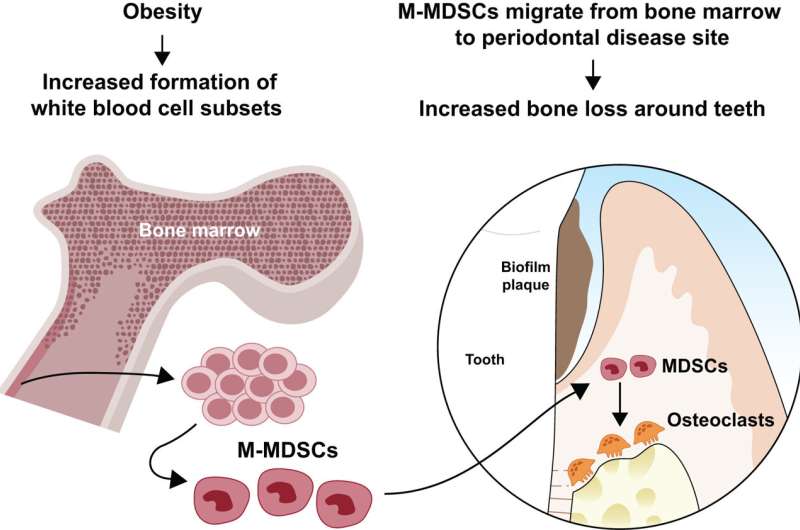Obesity raises the risk of gum disease by inflating growth of bone-destroying cells

Chronic inflammation caused by obesity may trigger the development of cells that break down bone tissue, including the bone that holds teeth in place, according to new University at Buffalo research that sought to improve understanding of the connection between obesity and gum disease.
The study, completed in an animal model and published in October in the Journal of Dental Research, found that excessive inflammation resulting from obesity raises the number of myeloid-derived suppressor cells (MDSC), a group of immune cells that increase during illness to regulate immune function. MDSCs, which originate in the bone marrow, develop into a range of different cell types, including osteoclasts (a cell that breaks down bone tissue).
Bone loss is a major symptom of gum disease and may ultimately lead to tooth loss. Also known as periodontal disease, gum disease affects more than 47% of adults 30 years and older, according to the Centers for Disease Control and Prevention.
"Although there is a clear relationship between the degree of obesity and periodontal disease, the mechanisms that underpin the links between these conditions were not completely understood," says Keith Kirkwood, DDS, Ph.D., professor of oral biology in the UB School of Dental Medicine.
"This research promotes the concept that MDSC expansion during obesity to become osteoclasts during periodontitis is tied to increased alveolar bone destruction. Taken together, this data supports the view that obesity raises the risk of periodontal bone loss," says Kyuhwan Kwack, Ph.D., postdoctoral associate in the UB Department of Oral Biology.
The study examined two groups of mice fed vastly different diets over the course of 16 weeks: one group a low-fat diet that derived 10% of energy from fat, the other group a high-fat diet that drew 45% of energy from fat.
The investigation found that the high-fat diet group experienced obesity, more inflammation and a greater increase of MDSCs in the bone marrow and spleen compared to the low-fat diet group. The high-fat diet group also developed a significantly larger number of osteoclasts and lost more alveolar bone (the bone that holds teeth in place).
Also, the expression of 27 genes tied to osteoclast formation were significantly elevated in the group fed a high-fat diet.
The findings may shed more light on the mechanisms behind other chronic inflammatory, bone-related diseases that develop concurrently with obesity, such as arthritis and osteoporosis, says Kirkwood.
More information: K.H. Kwack et al, Novel Preosteoclast Populations in Obesity-Associated Periodontal Disease, Journal of Dental Research (2021). DOI: 10.1177/00220345211040729





















